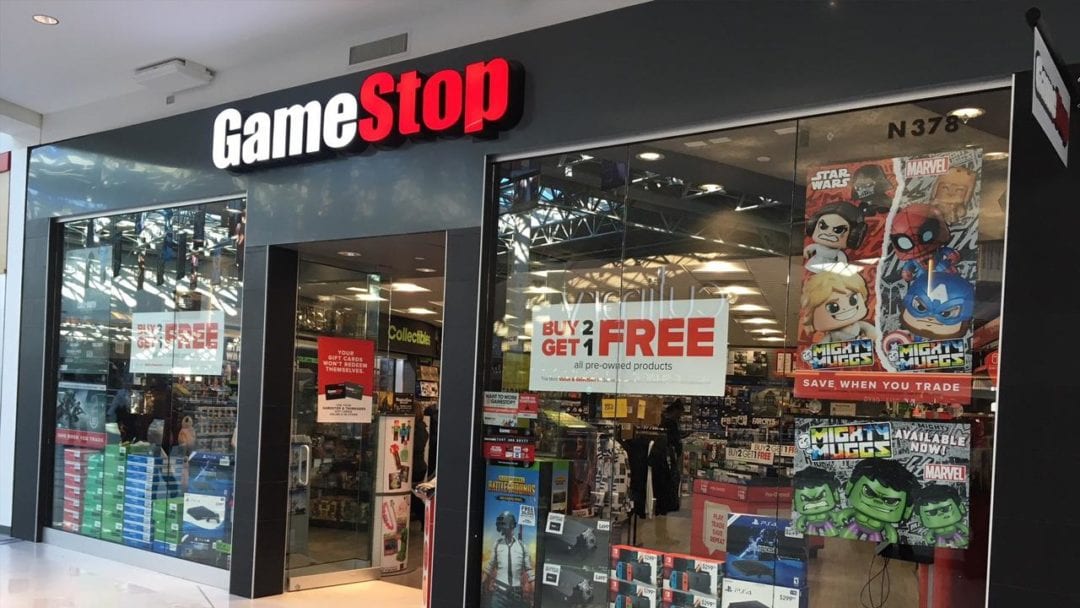If you haven’t heard the news, GameStop is in trouble. It’s been in trouble for years thanks to declining retail sales. Recently the trouble got worse. The company was looking for a buyer, and that deal fell through. Sales are down, it’s losing money, and it doesn’t seem to have a plan for the future. The company is also having trouble finding a stable CEO.
Five years ago — perhaps sensing that there wasn’t a bright future in retail gaming outlets — the company branched out and bought Spring Mobile. That probably seemed like a safe bet at the time, but now mobile phones have hit a feature plateau and the general public has stopped upgrading their devices every year. Not only is GameStop’s flagship sinking, but its lifeboat has a hole in it.

Don’t Blame Digital
The conventional wisdom is that GameStop fell to digital sales. Like Blockbuster Video, it was a company based on old technology that was quickly becoming obsolete. While there’s certainly some truth to this, I think this reading doesn’t take into account the decades of mistakes that brought the company to this point.
20 years ago, I was the ideal GameStop customer. I stopped in often and I was always looking for something new. I liked having boxed copies of games. I liked filling up bookshelves with games. I hated Steam and wanted nothing to do with it. All GameStop had to do to keep my business was offer things for me to buy.
I don’t know what GameStops looked like elsewhere in the world, but where I lived the locations were set up so that the right side of the store was dedicated to PC gaming, and the left side to console gaming. Then the PC section was cut in half to make room for Xbox games. That may have been fair, but the PC selection continued to shrink and was eventually relegated to a single freestanding display. Then it was limited to just part of that display. Then it was limited to a single small shelf on the display. By the time Nintendo’s Wii came out, the entire PC gaming section of GameStop was a single shelf that only contained World of Warcraft and the Diablo: Battle Chest. Those were good games to be sure, but everyone already owned them.
Even when I was shopping for console games, GameStop didn’t have anything to offer that I couldn’t get somewhere else. They sold used games, but not interesting used games. It wasn’t a good place to go if you were looking for old classics. Their shelves were focused on the biggest AAA titles for the current consoles. I showed up week after week wanting to browse for something new or exciting, but GameStop didn’t have anything for me to buy. This is the entire point of having a boutique store: it’s supposed to offer specialty goods you can’t get at conventional shops.
On top of this, the GameStop shopping experience was terrible. Between the upselling sales pressure for needless products like “protection plans” on games and cringeworthy attempts to pretend like preordering was necessary due to a supposed shortage of boxed copies, it wasn’t a fun place to shop. This isn’t the fault of the employees. All these annoyances were corporate policy. Regardless of what platform I was shopping for, I could always go to a big box store and browse a larger selection of titles in a more relaxed environment.
If your store’s shopping experience is more stressful than Walmart, then you have done something absurdly wrong.
Why did Walmart have a better selection of PC games and hardware than this specialty gaming shop? Why did GameStop have more shelf space dedicated to identical copies of Halo than all of their PC titles combined? Did the GameStop executives ever try shopping at one of their own locations? Were they aware of how uncomfortable it was?
I didn’t abandon GameStop for Steam. GameStop drove me away.
Seller’s Remorse
GameStop is most infamous for their trade-in prices. Their scheme to turn their supposedly upscale gaming boutiques into creepy pawn shops was so unpopular that it’s now the first thing everyone thinks about when they hear the name.
Back in 2007, my kids wanted a Wii. We were short on cash at the time and our GameCube had been gathering dust for months, so I thought it would be a good idea to trade it in to take the edge off the Wii sticker price. The purchase wound up costing more than I expected. When I checked the receipt later, I discovered this was because GameStop had offered me basically nothing for our GameCube, the pile of controllers, and our stack of games, all of which were in excellent condition. The price they gave us was insultingly low. Even in an exchange between good friends, I’d be embarassed to offer such a small amount. This wouldn’t be so bad if the used goods at GameStop were irresistibly cheap, but they were also appalling. It wasn’t uncommon to see a used copy of a game sitting on the shelf for $55, right next to the new copy priced at $60.
I realize that GameStop is running a business and I’m not arguing against the company making money on the second-hand market. My problem is that GameStop’s prices were so bad that it just wasn’t worth doing business there. The trade-in prices were next to nothing and the used prices were next to new. It was a bad place to go, regardless of whether you were buying or selling.
The day I sold my GameCube was the last time I spent money at GameStop. They got a really good price on my hardware, but they lost my business forever.
I didn’t stop shopping at GameStop because I wanted to go digital. I stopped going there because it was a ripoff and a bad experience.
GameStop PC Downloads
One of the famous blunders of the internet age is when Blockbuster Video passed up the chance to buy the nascent Netflix service for just $50 million. This happened in the year 2000, when Blockbuster was in decline and Netflix had just begun to rise. Netflix is worth over $32 billion today. Buying it in 2000 for $50 million would have resulted in a 64,000% return on investment. That could have saved Blockbuster by allowing it to transition to streaming as the physical media market dried up. Blockbuster could still be around today, although I admit “Blockbuster & Chill” doesn’t have quite the same ring to it.
The only thing worse than passing up a shot at financial salvation is paying money for that salvation and then sabotaging it. Imagine if Blockbuster had paid for Netflix, and then quietly shut it down three years later, thus flushing that $50 million down the drain for nothing. In that scenario, one of the other home streaming services would have risen to fill the void, and Blockbuster would have met the exact same fate. This is exactly what GameStop did.
Back in 2011, GameStop purchased Impulse, which was one of the very few competitors to Steam at the time. It was rebranded as GameStop PC Downloads, which is probably the least interesting name GameStop could have given it. Three years later they shut it down. Even while it was running, they seemed to have no idea what to do with it. The company never made any visible effort to promote or improve the platform.
Why did GameStop buy an entire platform if it didn’t have a plan for it? Once committed, why didn’t GameStop come up with a plan? By 2014 it was clear that digital downloads were large and growing. Why shut down an established storefront in a growing area of the market?
GameStopped
It’s reasonable to say that GameStop’s original business model was doomed by the rise of digital sales, but I don’t like to reduce this story to that one issue. The end of GameStop was hastened by its own foolishness, lack of foresight, and grasping economic model built on bilking customers when it came to selling and buying used products. The company was reviled by both customers and suppliers, didn’t offer anything its competition couldn’t, and spurned the one thing that might have saved it.
I’m not shocked to see the company in this death spiral, but I am surprised it took GameStop this long to get here. While I miss having a shelf full of attractive game boxes to represent my collection, I’m not sad to see the end of this clumsy behemoth. Our hobby deserved better.







Published: Feb 19, 2019 09:00 am